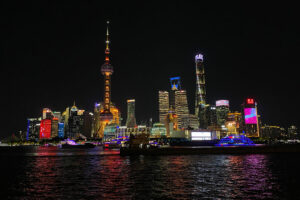
Shanghai’s ‘kitchen’ skyline
SHANGHAI, the city most visited by tourists in Mainland China, is known for its iconic skyline and rich cultural heritage.
The Bund, Shanghai’s famous waterfront area along the western bank of the Huangpu River, is home to luxury hotels, restaurants, and high-end shops. It is also where one finds what is known as the Bund Skyline. Its distinct look comes from a number of skyscrapers that together look like a set of kitchen tools.
One of these “kitchen tools” is one of the tallest buildings in the world, the Shanghai Tower.
Standing 2,073 feet tall, Shanghai Tower is currently the third-highest building in the world according to the Council on Tall Buildings and Urban Habitat. With its twisting structure that gradually narrows as it ascends the sky, the tower is called the “egg whisk.”
Known for its striking appearance, the tower’s spiral design was meant to enhance its structural stability and resistance to wind forces.
Next to the whisk is the “bottle opener,” or the mixed-used Shanghai World Financial Center.
With a height of 492 meters, or 1,614 feet, it is another prominent skyscraper, especially with its distinctive trapezoidal aperture at the peak.
The building serves as a financial hub with office spaces, conference facilities, hotels, and observation decks.
The third tool in Shanghai’s kitchen set is a cooking syringe, or the 1,380-foot Jin Mao Tower.
Completed in 1999, the building houses a five-star hotel, exhibition halls, banquet halls, an observation deck, and entertainment facilities.
The tower offers a “wander in the cloud” service wherein visitors can stroll along a glass skywalk — without rails! — on its 88th floor.
These three together are the tallest buildings in Shanghai and are among the many tourist destinations in the city.
SHOPPING
Located on the eastern coast of China, Shanghai is home to almost 29.87 million people, making it the third largest city by population in the world, according to the World Population Review.
To cater to the shopping needs of so many people, the city has the pedestrianized Nanjing Road, which spans approximately 5.5 kilometers. Known to be among the world’s longest shopping precincts, the street starts from the Bund facing the Huangpu River in the east to Jing’an Temple in the west.
The stores lining the street sell Chinese delicacies like candies, pastries, and teas; clothes and accessories; and cosmetics.
The street also has stalls for artists who do caricatures of tourists, with prices starting at 20 Chinese yuan, depending on the drawing style.
The road is also home to famous international brands housed inside the many department stores scattered along its length. One of these department stores focuses on collectibles for animé, manga, games, and manhua fans, and is easily recognized by the large inflatable animé character, Anya, on its rooftop.
Not every building along Nanjing Road is dedicated to shopping.
One of the buildings with a colorful history is the Fairmont Peace Hotel, first opened in 1929. Previously called the Cathay Hotel, it is located in the Sassoon House of Anglo-Jewish real estate tycoon Victor Sassoon. The hotel welcomed many distinguished guests through the years, including General George C. Marshall, actors Charlie Chaplin and Douglas Fairbanks, and playwrights Noel Coward and George Bernard Shaw. During World War II, the hotel was occupied by the Japanese army and later used as a social club for officers.
Nanjing Road is not the city’s only shopping area. Another is Tianzifang, a trendy area known for its boutiques, galleries, and vibrant nightlife.
Located in the French Concession area of Shanghai, Tianzifang is made up of narrow alleyways where visitors can browse through shops selling handicrafts, artwork, clothing, and souvenirs.
Originally filled with factories along its lanes, the area was renamed after the earliest recorded painter in China after it developed a thriving art scene. — Justine Irish D. Tabile



